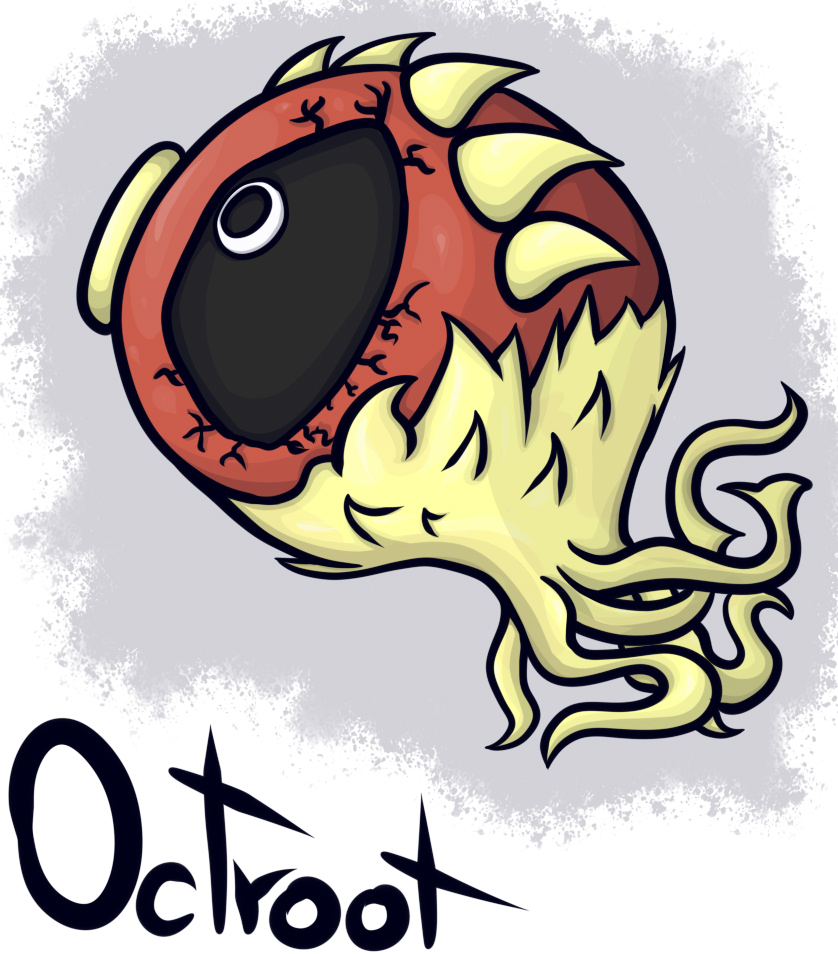Octroot
Octroot are Natura CosiPlants N/A that reside deep undersea, living in the dark areas of the seabed.
These medium-sized creatures have an appearance inspired by the original form of one of the Beasts of the Sea, which has been known by many names over time: Octopus, Octomutan, Necropuss. Octroot mimics the features of this beast, with a large, round red head, a yellow mouth, and yellow root-like tentacles. The key differences are the spikes on top of their head, the color of their tentacles, and their black eyes with white pupils.
Octroot are barely conscious, similar to N.M.S. with which they share classification. It is believed that Octroot evolved from N.M.S., though some argue that N.M.S. evolved from Octroot.
Octroot evolved to mimic the appearance of one of the Beasts of the Sea, specifically the original form of the ancient Octopus before it morphed into Octomutan. This mimicry serves as a defense mechanism, as many deep-sea creatures have evolved to avoid the Beast on sight. Octroot's resemblance to the Beast helps scare off predators that confuse it with the actual Beast.
Octroot inhabit dark areas to make their disguise more effective. However, as plants, they still require sunlight. Every few days, they use their tentacle-like roots to swim upward to absorb sunlight, though they try to remain in shaded areas or do this only when they sense no other dangerous species around.
Because most predators are scared off and avoid interaction with Octroot, their actual physical defenses are quite low. Their eyes specifically are delicate and represent a significant weak point. Severe damage to the eyes can trigger a chain reaction that affects the Octroot’s other organs, leading to death.
Octroot’s roots can be used to gather food from water currents and to dig into the seabed in search of matter and minerals that the roots can later absorb. They can also consume matter directly by shuffling it into their mouths, though this method is less energy-efficient.
Their primary predators are large creatures like Balleys and the actual Beasts of the Sea. The Beast that Octroot mimics is particularly aggressive toward them, attacking and devouring them on sight.
If Octroot senses the presence of large creatures in the water currents, they can use their roots to move to safer areas to escape potential dangers, though they are slow and not very adept at it.
Octroot reproduce asexually. An adult Octroot can spit red seeds from its mouth that can grow into new Octroot. These tube-shaped seeds can absorb matter that passes through them, including microorganisms and dead matter. Unlike mature Octroot, their seeds are commonly eaten by many sea creatures as a primary food source.
Over the years, both sea creatures and people have been fooled by Octroot’s disguise, leading to numerous false reports of Beast sightings. This confusion once led to the belief that the Beast could reproduce and that Octroot were its offspring, a theory since disproven.
As the appearance of the Octopus has changed over time, leading to names like Octomutan and Necropuss, Octroot have continued to mimic the Beast's original form. This gives a glimpse into the original appearance of the Beast. It is thought that either Octroot will evolve to mimic the Beast’s current form, or their disguise will become outdated, leading to their eventual extinction.

Branch: Natura
Category: CosiPlants
Subcategory: N/A
Etymology: "Octopus" + "Root"
Sex Ratio: Sexless
Sapience: ---